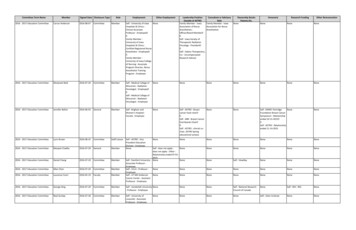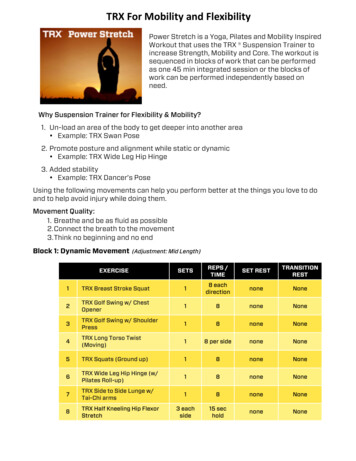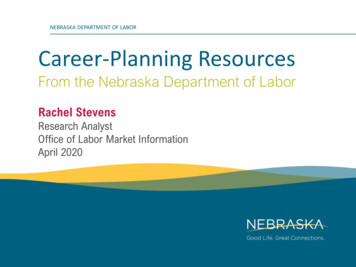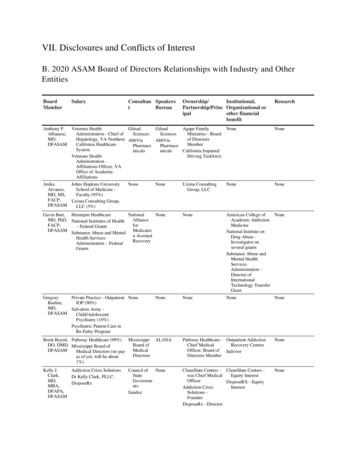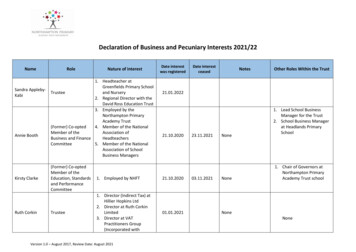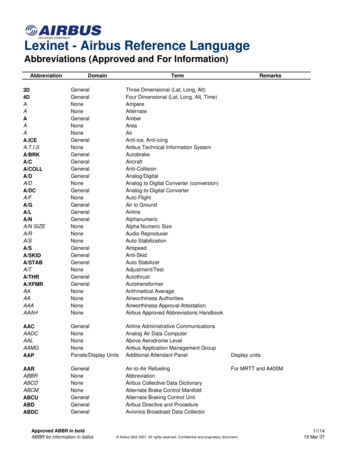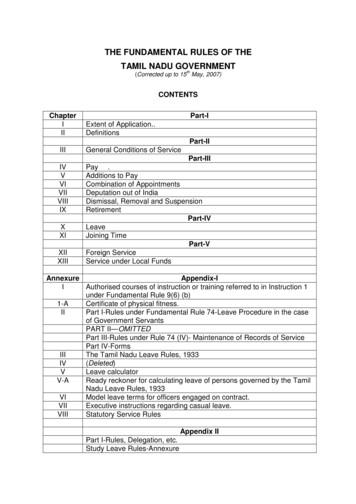
Transcription
“Leave None to Tell the Story”Genocide in Rwandawritten by Alison Des Forgesbased on research byAlison Des ForgesEric GilletTimothy LongmanCatherine ChoquetMichele WagnerKirsti LattuTrish HuddlestonJemera Rone
Copyright March 1999 by Human Rights Watch.All rights reserved.Printed in the United States of America.ISBN: 1-56432-171-1Library of Congress Catalog Card Number: 99-61313Cover photograph Gilles PeressCover design by Rafael JiménezCartoons and cover from Kangura reprinted Rwanda, Les médias du génocide, courtesy of Jean-PierreChrétien, Jean-François Dupaquier, Marcel Kabanda and Joseph Ngarambe.Addresses for Human Rights Watch350 Fifth Avenue, 34th Floor, New York, NY 10118-3299Tel: (212) 290-4700, Fax: (212) 736-1300, E-mail: hrwnyc@hrw.org1522 K Street, N.W., #910, Washington, DC 20005-1202Tel: (202) 371-6592, Fax: (202) 371-0124, E-mail: hrwdc@hrw.org33 Islington High Street, N1 9LH London, UKTel: (171) 713-1995, Fax: (171) 713-1800, E-mail: hrwatchuk@gn.apc.org15 Rue Van Campenhout, 1000 Brussels, BelgiumTel: (2) 732-2009, Fax: (2) 732-0471, E-mail:hrwatcheu@skynet.beWeb Site Address: http://www.hrw.org
Human Rights WatchHuman Rights Watch conducts regular, systematic investigations of human rights abuses in someseventy countries around the world. Our reputation for timely, reliable disclosures has made us anessential source of information for those concerned with human rights. We address the human rightspractices of governments of all political stripes, of all geopolitical alignments, and of all ethnic andreligious persuasions. Human Rights Watch defends freedom of thought and expression, due processand equal protection of the law, and a vigorous civil society; we document and denounce murders,disappearances, torture, arbitrary imprisonment, discrimination, and other abuses of internationallyrecognized human rights. Our goal is to hold governments accountable if they transgress the rights oftheir people.Human Rights Watch began in 1978 with the founding of its Europe and Central Asia division (thenknown as Helsinki Watch). Today, it also includes divisions covering Africa, the Americas, Asia, andthe Middle East. In addition, it includes three thematic divisions on arms, children’s rights, andwomen’s rights. It maintains offices in New York, Washington, Los Angeles, London, Brussels,Moscow, Dushanbe, Rio de Janeiro, and Hong Kong. Human Rights Watch is an independent,nongovernmental organization, supported by contributions from private individuals and foundationsworldwide. It accepts no government funds, directly or indirectly.The staff includes Kenneth Roth, executive director; Michele Alexander, development director; ReedBrody, advocacy director; Carroll Bogert, communications director;Cynthia Brown,program director;Barbara Guglielmo, finance and administration director; Jeri Laber special advisor; Lotte Leicht,Brussels office director; Patrick Minges, publications director; Susan Osnos, associate director;Jemera Rone, counsel; Wilder Tayler, general counsel; and Joanna Weschler, United Nationsrepresentative. Jonathan Fanton is the chair of the board. Robert L. Bernstein is the founding chair.The regional directors of Human Rights Watch are Peter Takirambudde, Africa; José Miguel Vivanco,Americas; Sidney Jones, Asia; Holly Cartner, Europe and Central Asia; and Hanny Megally, Middle Eastand North Africa. The thematic division directors are Joost R. Hiltermann, arms; Lois Whitman,children’s; and Regan Ralph, women’s.The members of the board of directors are Jonathan Fanton, chair; Lisa Anderson, Robert L. Bernstein,William Carmichael, Dorothy Cullman, Gina Despres, Irene Diamond, Adrian W. DeWind, FionaDruckenmiller, Edith Everett, James C. Goodale, Vartan Gregorian, Alice H. Henkin, Stephen L. Kass,Marina Pinto Kaufman, Bruce Klatsky, Alexander MacGregor, Josh Mailman, Samuel K. Murumba,Andrew Nathan, Jane Olson, Peter Osnos, Kathleen Peratis, Bruce Rabb, Sigrid Rausing, Anita Roddick,Orville Schell, Sid Sheinberg, Gary G. Sick, Malcolm Smith, Domna Stanton, and Maya Wiley. Robert L.Bernstein is the founding chair of Human Rights Watch.
International Federation of Human RightsThe International Federation of Human Rights is an international nongovernmental organization for thedefense of the human rights enshrined in the Universal Declaration of Human Rights of 1948. Createdin 1922, it includes 105 national affiliates throughout the world. To date, FIDH has undertaken morethan a thousand missions for investigation, observation of trials, mediation or training in some onehundred countries. FIDH enjoys consultative status with the United Nations, UNESCO, the Council ofEurope, the International Labour Organisation and observer status with the African Commission ofHuman and People’s Rights. Patrick Baudouin is President (France). The international Board iscomprised of Pascuale Bandiera (Italy), Abdellaziz Bennani (Morocco), Akin Birdal (Turkey), MichaelEllman (Great Britain), Fernando Gomes (Guinea Bissau), Cecilia Jimenez (Philippines), Sidiki Kaba(Senegal), Karim Lahidji (Iran), Lucie Lemonde (Canada), Adrian Ramirez Lopez (Mexico), FranciscoSoberon Garrido (Peru), Michel Tubiana (France), Alirio Uribe (Colombia), Vo Van Ai (Vietnam),Saadeddine Zmerli (Tunisia), vice presidents; William Bourdon (France), Claude Katz (France),François-Xavier Nsanzuwera (Rwanda), Desanka Raspopovitch (Federal Republic of Yougoslavia) andOdile Sidem-Poulain (France) are secretary generals; Philippe Vallet (France) is treasurer. The Africateam within the executive board is composed of Catherine Choquet, joint general secretary, Eric Gilletand coordinator for Burundi and Rwanda. Antoine Bernard is the executive director of FIDH, andEmmanuelle Robineau-Duverger is responsible for Africa at the international secretariat.Address for FIDH17, Passage de la Main d’Or, Paris 75011, FranceTel : (331) 43 55 25 18Fax : (331) 43 55 18 80E-mail : fidh@csi.comhttp://www.fidh.org
ContentsIntroduction . 1The Genocide .3The Strategy of Ethnic Division . 3Preparations for Slaughter .4The Attack .4Recruiting for Genocide . 5The Structure. 6Strategies of Slaughter . 7Popular Participation . 8The Masquerade of Legitimacy . 9Survival Tactics . 10The End of Hutu Power. 10The Rwandan Patriotic Front . 10Numbers . 12International Responsibility . 13Tolerating Discrimination and Violence . 13Economies and Peacekeeping . 14Warnings, Information and the U.N. Staff . 14Obfuscation and Misunderstanding . 15Genocide and War . 16Military Action and Inaction . 17Tolerating Genocide . 19Rwandans Listened . 20The Future . 21The Research Project .22Language, Spelling and Names . 23The Context of GenocideHistory . 25The Meaning of “Hutu,” “Tutsi,” and “Twa” . 25Colonial Changes in the Political System. 27The Transformation of “Hutu” and “Tutsi” . 28The Hutu Revolution .30Habyarimana in Control . 32The Single-Party State . 32The Army, the Church and the Akazu . 33Prosperity, Short-Lived and Superficial . 35Threats to the MRND Monolith .36Opposition within Rwanda .36The RPF Attack. 37The Government Response to the Attack . 37Consolidating the Opposition .39
Kubohoza, “To Help Liberate” . 41Impunity and Insecurity . 44The Military Defines “The Enemy” . 45Propaganda and Practice .48The Media .49Validating the Message . 52The Message . 53“Tutsi Unity” . 54“Infiltration”. 55“Restoring the Old Regime” . 56“Genocide of the Hutu” . 57The Regional Context . 58“The Hutu as Innocent Victim” . 59“The Tutsi Cause Their Own Misfortune” . 60“Hutu Solidarity” . 60The Mugesera Speech: “Do Not Let Yourselves Be Invaded” . 61Practicing Slaughter .63Choosing the Target .63Feeding the Fear .64Directing the Attacks . 65Lying about the Violence . 66Impunity . 66International Response to the Massacres . 67The International Commission of Inquiry into Human Rights Abuse in Rwanda . 68Choosing War . 69He Who Wishes for Peace Prepares for War . 70Arms . 70Lists . 71The Militia and “Self-Defense” . 73The AMASASU and Colonel Bagosora . 74Locating Potential Leaders . 78The February 1993 Attack . 78Splitting the Opposition . 80French Support for Habyarimana.83The Costs of War . 87The Arusha Accords . 88Opposition to the Accords . 89Buying Machetes . 90Recruiting Supporters . 91Recruitment by the RPF . 92The United Nations Peacekeepers . 92Resources and Mandate .93Paragraph 17 .94The Assassination of Melchior Ndadaye and Violence in Burundi . 95Hutu Power . 97
Warnings. 99Chronology. 100November 1993 . 100December 1993 . 101January 1994 . 103February 1994 . 112March 1994 . 117April 1994 . 120The U.N. Response to the Warning . 120Responses of the French, U.S., and Belgian Governments . 122A Solemn Appeal . 124Renewing the Mandate . 124Genocide at the National LevelApril 1994: “The Month That Would Not End” . 126The Attack on Habyarimana’s Plane . 127Taking Control . 130Bagosora In Command . 130“The Prime Minister Isn’t Working Anymore.” .131Ambiguities and Double Language . 134The Interim Government . 137Launching the Campaign . 139The Initiators . 139Sharpening the Focus on Tutsi .141Military Opposition: The April 12 Statement . 143Strategies of Slaughter . 143Priority Targets . 143Thorough Elimination: “Begin on One Side.” . 145Massacres. 146Impeding Flight: Barriers and Patrols . 148Rape and Sexual Servitude . 150Crimes of Extraordinary Brutality . 150Strategies of Survival. 151Resistance . 151Flight, Hiding, and Buying Safety . 153The Organization . 154The Military . 155Politicians and Militia . 157The Militia . 158The Administration . 161Passing the Word . 161Mobilizing the Population. 162Enforcing Regulations . 165Support Services: Ideas and Money . 168The Clergy . 170
The Radio: Voice of the Campaign . 173Deception, Pretext, and Pretense . 175Popular Participation . 181Extending the Genocide . 182Removing Dissenters . 183Continued Conflicts Among the Military . 184Destroying Opposition in Gitarama . 187“The Population Is Trying to Defend Itself” . 193Tightening Control . 196Restoring to Rwanda “Its Good Name” . 197“Violence.Should Stop”. 199“No More Cadavers.On the Road” . 200“Pacification” as Deception .202“Justice” During the Genocide .204Mid-May Slaughter: Women and Children as Victims . 205“Opening a Breach to the Enemy”: Conflicts Among Hutu . 206Political Struggles . 207Disputes Over Property . 207“Where Will It End?” . 208RPF Victory . 209Genocide at the Local Level: Gikongoro and ButareGikongoro . 211Background . 211Bypassing the Prefect . 213Sub-Prefect Damien Biniga . 214Lieutenant Colonel Simba. 215First Attacks . 216Moving the Violence Outward . 218The Radio Targets Tutsi. 219Musebeya . 219The Burgomaster Opposes the Genocide .220Simba Takes the Lead . 222The Barriers. 224“We Must Exterminate Them All!” . 225“No Words for Solving the Problem” . 227Attacking Dissenters .228National Authorities Spur the Slaughter . 230Kivu: Evading Responsibility . 230Eliminating the Tutsi at Musebeya . 232Massacre at Kaduha . 233Tightening Control .239“Pacification” in Gikongoro .240“Civilian Self-Defense” in Gikongoro . 242Removing the Burgomaster of Musebeya . 243
Nyakizu: The Massacres . 244Butare: The Prefect and the Prefecture . 245Nyakizu Commune . 245Burgomaster Ntaganzwa: Victory Through Kubohoza .246Consolidating Control .248Hutu Power . 250The Border and the Burundians . 251Training and Arms . 253Beginning the Genocide . 255Gathering the Tutsi, Mobilizing the Hutu . 256The First Killings . 258Nkakwa . 260Cyahinda.262The “Battle” .264Improving Participation . 267Promises of Help, Threats of Reprisals . 270The Hilltops . 273Flight . 276Nyakizu: The Administration of Genocide . 278Restoring “Normal” Life . 278The Language of War . 280Cleaning Up . 281“Clear the Remaining Brush” .
Human Rights Watch Human Rights Watch conducts regular, systematic investigations of human rights abuses in some seventy countries around the world.
